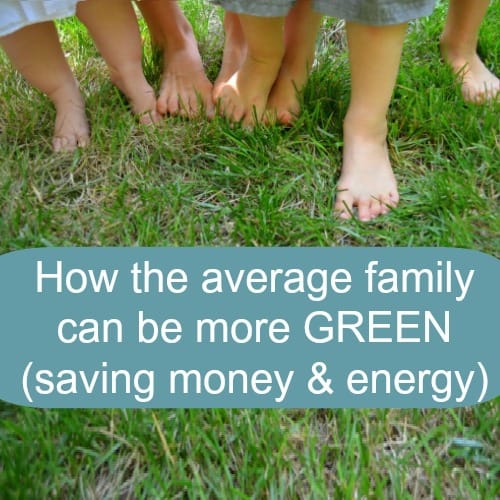This post may contain affiliate links. Please read our disclosure policy.
We have six people in our family and we try to be as eco-friendly as possible. Today I want to share how an average family can be more green (and save money doing it!)
To be honest, I am not one of those “Green” people- not to the extreme, anyways. I try to be
as much as I can, but I still use paper plates at times and we use throw-away napkins. I drive our kids to preschool and we use our car often, without giving it much thought. I do, however, try to be eco-friendly when it is possible, in simple ways (like you will see below).
Here are five ideas to get you started…
1- Plant a garden & eat what you grow.
Here are my tips to grow a garden when you are new to gardening (with a great recipe for zucchini pie) and here is another post with 10 ideas to get your kids involved with your garden (educational ideas)Gardens are really easy to make, too. You can connect one to a fence, like we did in our house and like our neighbors have done. Look how easy it is to make:
Here is our little girl eating a popsicle made out of what could easily be grown in a garden! (Here is the recipe for high protein popsicles)
2. Turn your water heater down.
First, if you have kids, you want to turn it down to prevent accidental burning. Kids 4 and under are at the highest risk. Keep it below 120 degrees. When we go out of town, we turn it down even more. You can wrap a water heater blanket around your water tank (it is insulated). This cuts the heat loss by over 30% normally. Up to 40%. We have had one in every house. Check your manual, too, as it may already be insulated.
If you can’t turn your water down, you can install antiscald devices on faucets and shower heads to prevent burns in children. This antiscald device will not let the water get over 120 degrees.
3. Toilets- you can either get a low-flow toilet (they are expensive- around $350) or you can just displace the water. You do this by filling a clean jug with water or rocks (you want to weigh it down). Lower it carefully into the back tank of the toilet. Replace the lid. You will use less water with each flush.
4. Use a dishwasher! Hand-washing dishes tends to actually use more water, unless you are cautious not to use a lot. You do not need to pre-rinse or soak your dishes, if the dishwasher is efficient. Also, try not to use the heated dry- just let them air dry. I also wait until it is completely full before running it.
5. Watch the times of day that you water the grass. Aim for 4:00 am to avoid using too much water (evaporation, etc…) Here are 10 tips for a green, healthy lawn (by my husband)
6- Adjust your heat/air
We do this with a smart thermostat. My Dad installed one for us in our first house and we have had one in everyone one of our three houses since then. We keep our heat a little cooler than most and our air a little warmer than most. As my brother reminds me when I say that I should turn it up in the winter, “You shouldn’t be wearing a tank top in the winter. You should be wearing a sweater. So, dress for that weather and you will be fine in your house.” Good point!
Here is a look at our family’s temperature settings, if it helps (this is how we set our smart thermostat):
Winter- 68 in the day, 71 or 72 at night.
Summertime- 78 in the day, 82 if we are not going to be home (vacations, work) and 76 if we have people over (I get cold very fast, so 78 is perfect for me!)
Many thanks to Direct Energy for sponsoring today’s story and inspiring us to live a smarter and more eco-friendly lifestyle with these tips for smart house …
You can find 10 more ways to save money while being more eco-friendly here




















Great tips! I’ve never heard of it before! Will talk with my husband tonight! Thanks!
Thanks, Kristen!